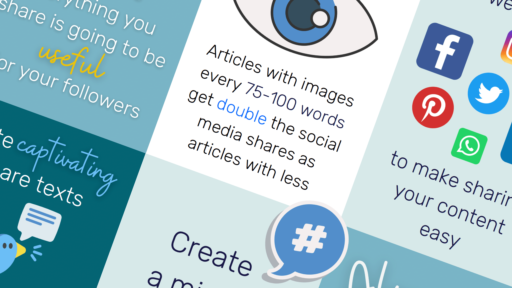Curated content needs to be part of your content marketing strategy. Especially on social media. But here’s the thing. Most people are doing it wrong.
Content curation is everything you share on your social channels that you didn’t create yourself. It needs to be high-quality and relevant to your target audience. Now, let’s say you’ve got that part nailed. How can you share content more effectively?
Well, there’s one hack you’re probably not using. Most likely because you’re short on time. But as you’re about to find out, spending a little time can go a long way.
Key takeaways
- You need to add unique insight to everything you curate
- Make sure you give people extra value (so you’re worth following)
- You could ask a question alongside the link
- Summarize the piece with bullet points
- Show off your expert opinion
- Pick out a good quote to highlight your thoughts on it
What is curated content?
Curated content is made by other people but shared by you. Like a museum or art gallery curator, you need to pick great content that fits your niche.
A medieval knight’s armor isn’t going to work in an exhibition about deep-sea creatures. See what we’re saying?
It’s all about finding the right content to share with your audience. You want to keep them coming back to your page for fresh content because they know they’re going to find value.

But other than search engines, where can you find different types of content to curate for your social networks?
Here are some examples:
- RSS feeds
- Social media content roundups
- Email newsletters
- Infographics from blog posts
- Hashtags specific to your industry
- Podcasts on Spotify or Apple
- Content curation tools (we’ll get to some of those at the end!)
Ok, so we understand the ‘what’. But what about the ‘why’?
What are the benefits of content curation?
We all know how time-consuming it can be to create new content, especially if you’re running a business with no team members. Your own content might take a back seat.
But you need a full schedule of social media posts to keep your audience interested.
Curated content is so great because it already exists. Someone else has done the hard work for you. You just have to pick out the right pieces of content to share.

When you’re trying to sell a product or service, it can be tempting to want to tell people about it constantly. Original content definitely has its place. But trust us, you don’t want to do this too often.
Content curation makes your brand look less self-promotional because you’re sharing a mix of relevant content from other people.
Some of the other benefits are that it:
- Helps you to network and develop relationships
- Builds trust with your target audience
- Keeps you up to date with trending topics and breaking news
- Lets you show off your expertise
- Keeps a full and varied content calendar
So, what is it that most people get wrong when curating content for social media marketing?
What do most people get wrong with curated content?
“Thought leader” is a term that’s thrown around a lot. Some people confuse them with influencers.
They’re the go-to people in their areas of expertise. On social media, they usually have a dedicated following.
Many are masters of content creation. But they know how to use the power of curated content too.
Resharing something is easy. Even retweeting someone else’s Tweets is a form of curated content. But that’s where a lot of people stop…and that’s where they get it wrong.

You see, anybody can retweet something. And that’s fine to do from time to time. But where’s the value in that for your audience long-term? They may as well follow the person who’s tweeting.
Which takes us to the one hack that will take your curated content to the next level.

Can you see what it is?
The one hack to take your curated content to the next level
Let’s assume you’ve got a solid bank of content to curate from. What’s going to elevate your curation process from the sea of reshares and retweets?
Adding unique value.
You need to show your audience exactly why the curated post you’re sharing is worth reading, watching, or listening to.
Rand Fiskin (Don of the SEO and marketing world) is an awesome example of exactly how to do this.


His style of curation on social media is to summarize the post briefly. But other times, he’ll just add his expert opinion.

There’s no set template, though. And there are tons of other ways to format your posts to add unique value to your content curation strategy.
How to add unique value to everything you curate
A lot of it will depend on your brand voice, which needs to be consistent. This will differ from business to business.
Of course, you’ll also need to read, watch, or listen to the content to be able to do this effectively.
But speaking generally, here are 4 ideas for different formats:
- Ask a question
- Summarize briefly
- Show off your expertise
- Pick out a good quote
Ask a question
Questions prompt engagement. Engagement is what builds a dedicated audience.
Richard Branson shares the story of a successful businessman who ended up on death row through tainted evidence. He then grabs your attention with his intriguing sign-off question – “If it could happen to him, could it happen to you?”

Summarize curated content briefly
Chronological content was replaced by algorithms a long time ago. Users end up endlessly scrolling through social media, not really knowing what they’re looking for. Something needs to make them stop.
A bite-sized summary of your curated content can tell people why they want to read it.
Check out Daniel Pink’s example below. He even summarized his summary in the final line, “The management lesson: talk less, listen more.”

This LinkedIn user summarized the 7 types of rest covered in the article in bullet points. Then finished by asking a question directly to the reader. If in doubt, why not try a mix of formats?

Show off your expertise with curated content
One of the main benefits of adding unique value to curated content is showing your expertise.
Neil deGrasse Tyson is an astrophysicist, here to make science accessible to the masses. The guy knows space, and he’s sure to give you his expert insight with everything he posts.
For example, this awesome explanation of how shooting stars occur. Who doesn’t want to know more about that?!

Organizational psychologist Adam Grant puts across his opinion with this curated article.
Rather than simply introduce the subject matter, he starts a discussion of his own by sharing his thoughts on the whole of the piece. Followers can then agree or disagree in the thread below.

Pick out a good quote or statistic
Sometimes, the best way to show the value of curated content is with a direct quote.
Organic farmers at Riverford chose to highlight an interesting statistic from an article about the lack of vegetable pickers in the UK. They summarized the main body of the article, then explained why it’s important to their business and their audience.

This LinkedIn user used a mix of quotes and statistics from the piece they found. You almost don’t need to read the whole piece to get the gist!

Whatever format you choose, just don’t forget the golden rule: always credit the source (if you’re not linking directly to it!)
3 content curation tools for social media
We’ve taken for granted that you know where to find the best content to curate and how to organize it all. If you don’t, here’s a bonus section.
Here are 3 content curation tools that can make life a lot easier:
- Quuu
Each has a free plan, so can fit in every marketing budget.
If finding great content is a breeze for you, try Pocket. It’ll make saving and organizing it all really easy.
It’s a simple app that lets you save content from anywhere on the web. Online or offline. It’s also integrated with over 1500 apps, so your favorite is bound to be included.

You can also add smart tags to customize your content into specific categories. The more you tag, the more personalized the suggested tags become.
Functionality is key with bookmarking apps and Pocket delivers. There are no frills, but that could be exactly what you want.
Quuu
If you’re not a fan of manually curating, Quuu does the searching for you. Every day, your curation assistant Robin will find and send you a mix of high-quality content that you can share to your social accounts.
Pick your most relevant interest categories, hook up your favorite scheduler and organize your posting in advance. HubSpot, Buffer, Hootsuite, and SocialBee are all integrated.

It works with 3 of the best social media platforms for curation – Twitter, Facebook, and LinkedIn. There’s a fully automated setting, but if you want to add that all-important unique value, we’d recommend choosing manual mode.
Flipboard is a news aggregation app. If you want to curate trending topics and real-time breaking news, this is the place to be.
The platform encourages you to create Smart Magazines. They are basically playlists of content from specific genres. But these magazines are not just made up of articles. You can include photos and videos too.
Once you’ve set one up, Flipboard will keep it updated automatically, so you never miss a thing.

Most of your favorite publications have their content on the platform. Although there is a section for trending global news, there are also specific topics, from fashion to wildlife. It’s also totally 100% free!
Conclusion
Curating should be an essential part of your content marketing mix. That’s a given. But there are only a limited number of marketers adding unique value to everything they curate.
You and your brand could stand out in a sea of mediocre curation simply by putting in a bit of manual effort.
It also makes it immediately clear to potential followers that your account is going to be valuable. Whether it’s interesting, entertaining, or inspiring content you’re sharing – don’t forget to have your say.
Do you try to add a personal twist to everything you curate? Who are some of your favorite curators on social media? Tell us in the comments!





